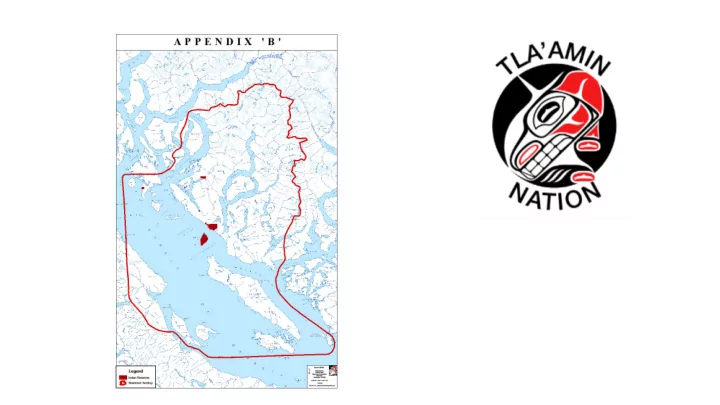

Tla’amin Nation (formerly Sliammon Indian Band) • Tla’amin Nation – became a self-governing Nation on April 5, 2016 after approximately 20 years of negotiations with BC and Canada • Population 1200 people • We are located on the Coast of British Columbia and are part of the Coast Salish Tribes • Tla’amin Nation has Shared Territory with several neighbouring First Nations and have signed Shared Territory Protocol Agreements with all. • Sister Nation to the Klahoose, Homalco and K’omoks Nations
Tla’amin Final Agreement • Came into effect April 2016 • Provides for defined (protected) areas for hunting, fishing and gathering • The right to hunt, fish, gather is limited only by measures necessary for conservation, public health and public safety • Tla’amin people maintain aboriginal rights throughout our Traditional Territoy • Continue to have rights to harvest in our Shared Harvest Area
The right to the resources • Some resources are allocated – ie. Salmon and some remain unallocated ie. Clams, deer, • Sustainable harvesting – reporting of data • Increasing demand from the commercial and tourism industry • Balance is needed • Important to be out on the land and know what is going on • Stewardship/Guardian watchman critical
Treaty Allocations and Food Security • The Final Agreement did provide for defined areas where we have the priority right ie. Fishing area, Wildlife Area – but we are still competing with industry and the general public for resources • There have been issues with commercial harvesting of seafood in our area • Crab – commercial harvesters – TN will request closure of areas fronting our community • Clams – “Tourism harvesters” • Mushrooms - implementation of permitting process
Baseline Information • It has become ever more important to have baseline information on the state of the resources in our Territory in order to ensure that our people continue to have access to the resources • FNFNES – Tla’amin participated in the study to ensure that these resources continue to be safe – we were happy to find out this is true • Biomonitoring – we participated in the biomonitoring initiative as well and thankfully the results are good • Beach surveys – we have begun conducting surveys pre and post tourism season to assess the impacts on our beaches • Contemporary Use Study – Update to the Traditional Use study conducted 30+ years ago – a survey to find out where our people are hunting, fishing, gathering, spiritual use – critical to respond to applications in the territory
Referrals - Protection of Aboriginal Rights • Off of Tla’amin Lands (Treaty settlement Lands) within our Territory • Wide range of referrals – from the Province, the Feds (Fisheries mostly), the City (subdivisions), industry and private properties • Reviewed for impacts to both Aboriginal and Treaty rights • In most cases require site visits from Technicians (at their cost) • Protection of Cultural and Archeological sites • Need to educate – the public and governments • Important to have internal capacity and good help
Recommend
More recommend